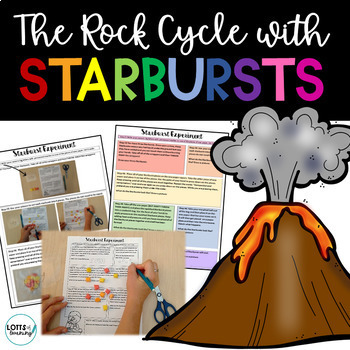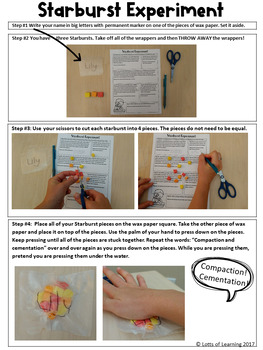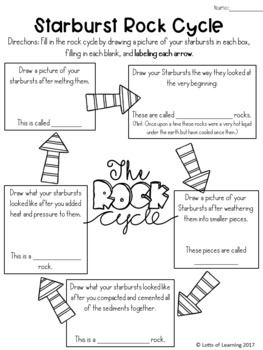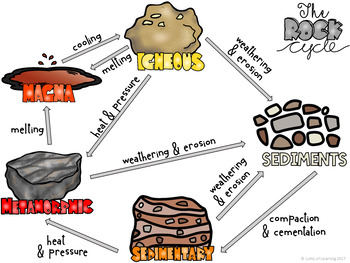Rock Cycle Lesson with Starbursts | Hands-on | Homeschool approved
- Zip
What educators are saying
Also included in
- Are you looking for a fun way to teach the three types of rocks (igneous, sedimentary, and metamorphic) and the rock cycle? Well, look no more! This bundle includes two engaging and hands-on lesson plans that use the 5E model to teach the 3 types of rocks and the rock cycle. Please click the previewPrice $6.50Original Price $8.00Save $1.50
Description
Are you looking for a lesson plan that introduces and explains the rock cycle in a fun way? This hands-on lesson uses the 5E model to teach the students that a rock can change from one type of rock to another. It has been classroom tested by me many times and definitely student approved! It has also been homeschool tested and parent/child approved. The lesson plan that comes with this resource is very detailed, making it perfect for homeschooling. Please click the preview where you can view every single page that is included in this product.
**Please note that this product is part of a bundle. If you are interested in buying this lesson plan AND a lesson plan that teaches the three main types of rocks for a discount price, then click HERE.**
Please also note that the two lesson plans mentioned above are part of my HUGE Rocks and Minerals Unit. If you are looking for 3 weeks worth of material that you can use to teach an entire rocks and minerals unit, then check out the unit.
THE LESSON PLAN
Students ENGAGE in a Starburst Experiment not knowing they are doing the rock cycle. (This leaves room for an "ah-ha" moment later.) They just follow the instructions in front of them and draw pictures as they go. First, they unwrap their Starbursts and cut them into pieces. Then they press those pieces together with their hands and pretend like they are doing it under water. While they are pressing the pieces together, they say, "Compaction and compression" over and over. After their pieces have been thoroughly pressed together, they place them in a baggie and use the heat of their hands, and pressure, to morph the Starbursts into a new shape. Then their Starbursts go in the microwave where they melt, and then back out to cool. A classroom discussion follows, where the students EXPLORE what was done to their Starbursts. They eventually realize that their Starbursts just went through the rock cycle! Then you EXPLAIN the rock cycle even more by displaying my eye-catching rock cycle poster(s). (For example, it's not always just one continuous circle). Vocabulary posters and teacher notes are included so that you can successfully explain each step of the rock cycle. After the rock cycle has been explained, this lesson challenges students to ELABORATE their understanding by having them fill out a flowchart. This flowchart has them draw their Starbursts again, but this time they label each step with its corresponding part of the rock cycle. To EVALUATE the students' understanding of the rock cycle, a blank rock cycle is provided, as well as an answer key. If you're looking for a way to evaluate their understanding that also incorporates narrative writing then you can use the "Rock Cycle Story" materials that I have included.
Here is everything that you're getting with this product: (please click the preview so you can see the quality of my work):
-An 8-page, detailed lesson plan that explains exactly what to say and what to do every step of the way.
-A page that explains how this lesson follows the 5E Model
-Detailed instructions that the students read and fill out while they do the Starburst experiment
-A set of instructions with pictures that could be used for ELLs
-A flowchart that the students fill out to elaborate their understanding of the rock cycle (an answer key is provided)
-A blank rock cycle worksheet and answer key that can be used as an assessment
-A rock cycle practice page (students fold it in half, fill it out, and then unfold it to check their answers.)
-Vocabulary posters/anchor charts (geologist, sediments, weathering, erosion, compaction and cementation, igneous rock, sedimentary rock, metamorphic rock, lava, magma, and much more!) There are MANY different designs and definitions to choose from.
-Rock cycle posters/anchor charts
-Narrative writing graphic organizers that you can use with the students. These graphic organizers guide the students as they write their own rock cycle story. When they are all done, they will have a story about a rock that begins as an igneous rock and then continuously changes as it goes through the rock cycle. At the end if their story, it has become a whole new new igneous rock. Instructions and a sample story are included.
I highly recommend teaching a lesson about the three main types of rocks (igneous, sedimentary, and metamorphic) and how they are made BEFORE teaching this lesson. This lesson assumes that students already have a fairly good understanding of the three main types of rocks that they can refer to during this lesson. If you are looking for a lesson plan that teaches the 3 types of rocks, then I've got you covered! I've got a detailed lesson plan that teaches the 3 main types of rocks. Just click HERE.
OR
If you are interested in purchasing this product AND my lesson on the three types of rocks, I have bundled them together for a discount price. Click HERE to get the bundle and save $2.00.
If you are looking for an entire rocks and minerals unit with 3 weeks worth of lesson plans, a study guide, a test, games, task cards, vocabulary posters and more, then check out my HUGE Rocks and Minerals Unit,. It includes this lesson plan as well as many other resources like it at a discount price.
If you are not interested in buying the entire unit and just want to buy other individual lesson plans, please consider the following:
Hershey's vs. Snickers: A lesson that introduces and explains the difference between a rock and a mineral in a fun and edible way.
Or perhaps you're interested in a Rocks and Minerals Test that you can use to guide your unit. It also includes a study guide and a review game.
Again, if you are interested in buying all of these products and many other products like this at a discount price, then please check out my HUGE Rocks and Minerals Unit.
Thank you for your interest! Please don't hesitate to ask any questions to get more information on these products and how I've used them in my classroom!
Check out My Facebook page for giveaways and product updates.
© Lotts of Learning 2017






